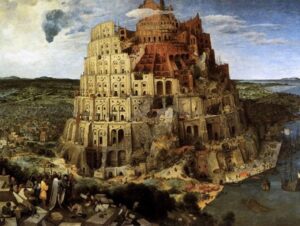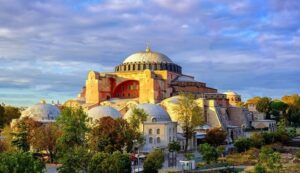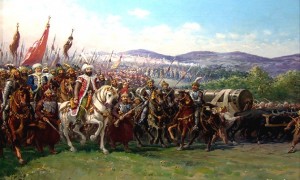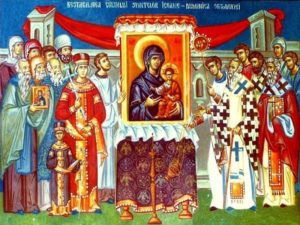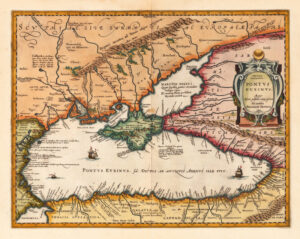Saint Nifon (teacher) and Maxim the Greek (student) as Models of the Ecumenicity of Orthodoxy
11 November 2012The synthesis and relationship between Greek Orthodox and Russian Orthodox spirituality has for long engaged the scholarly interest both of students of ecclesiastical history as well as of Orthodox Christian believers in general. Indeed, there was particular mobility and mutual influence between these two poles of Orthodox spirituality- Greek and Russian- during the period of Ottoman domination of the Balkan Peninsula. Within this ecclesiastical context, personalities of great spiritual authority arose, who had a positive influence on developments in the life of the Church and on the Orthodox spirituality of their times in general. Two such personalities were the Athonite saints Nifon, Patriarch of Constantinople and Maximos (Maxim) the Greek, enlightener of the Russians, who were linked through a relationship of teacher and pupil respectively.
During the preparation work for the presentation (in the academic periodical Γρηγόριος ο Παλαμάς [1], of the Holy Metropolis of Thessaloniki) of the volume: The Holy Monastery of Dionysiou, Saint Nifon, Patriarch of Constantinople 1508-2008), a Festal Volume on the 500th Anniversary of his Repose, Holy Mountain 2008, (p. 494), our interest was stimulated by, among other things, a study included in the book (pp. 198-207) by His Eminence Dimitrios (Kommatas), Metropolitan of Sevasteia, entitled: Saint Nifon as a Voice of the Ecumenicity of the Great Church of Christ [the volume is in Greek].
Our researches then turned to non-Greek encyclopedias, in an attempt to find entries on Saint Nifon. These efforts bore fruit when the presence was detected, in the excellent Russian encyclopedia Globar, published in Saint Petersburg in 1897, of a short, though ad hoc, entry on Nifon. In translation the entry says: “Nifon. Patriarch of Constantinople 1488-90, 1499-1500 (sic) [2]. After Nifon’s second election, he was invited by the Prince of Moldo-Wallachia, Radu IV, to guide the Metropolis of Moldo-Wallachia. He assisted the prince greatly in the organization of ecclesiastical and social works and attempted to effect spiritual progress among the leaders and the people. In 1504, Nifon left for the <Holy> Mountain, where he departed this life. The Church of Moldo-Wallachia honours him as a saint. His memory is celebrated on 11 August” [3].
Besides this, there is also a reference (in the festal volume in honour of Saint Nifon and the study Επιγράμματα εις τον Άγιον Νήφωνα (346-359 by Mihaïl, late Metropolitan of Austria and Exarch of Hungary and Central Europe), to the composition by Saint Maxim the Greek [4], during his time at the Monastery of Vatopaidi (1505-16), of three epigrams of high linguistic quality, one funereal and the other two for the reliquary of Saint Nifon. This demonstrates the close spiritual bond between the two holy scholars, who lived together for about three years in the monastery in question: “In the monastery also lived the scholarly former Ecumenical Patriarch Nifon II (1486-9, 1497-8). He was from the Peloponnese and maintained close ties with Byzantine scholars who lived in the West. The monk Maximos, of course, did not reject experiences acquired in the West, but was unable at that time to arrive at an objective appraisal of the humanists. His discussions with the former Ecumenical Patriarch Nifon helped Maximos to order these experiences and to understand more deeply the sharply anti-Latin outlook of Orthodox monasticism”[5].
So from at least as early as 1897, Patriarch Nifon II was well-known in Russia, on the basis of the encyclopedia entry, which notes that the saint was associated with the restoration of ties with the Orthodox Moldo-Wallachia lands. The same saint was also linked to the promotion of scholarly spiritual men, one of whom was the monk Maxim the Greek. It is clear that, during their three years together in the Monastery of Vatopaidi, he had a serious influence on Maxim (who was later to bring enlightenment and reform to the Church in Russia after the years of Mongol occupation), especially as regards the ecumenical nature of Orthodoxy. This is demonstrated, moreover, by the composition of the epigrams to which we referred above.
All of the above were good reasons to bring to the attention of the Russian academic community and the readership of the faithful in Russia in general the festal volume about Saint Nifon, Patriarch of Constantinople, through the book presentation mentioned above. The presentation chosen was the study by His Eminence Dimitrios (Kommatas), Metropolitan of Sevasteia, entitled: Saint Nifon as a Voice of the Ecumenicity of the Great Church of Christ, translated into Russian His Eminence analyzed in the round the example of Saint Nifon as ecumenical luminary and teacher, in particular of Maxim the Greek, and especially during their time together at the Monastery of Vatopaidi.
After a comprehensive review and easily-understood, but substantial reference to the conditions which obtained in Orthodoxy, which, in the years immediately following the capture of Constantinople had become centred on the Balkans, he draws the conclusion that in the course of his life (Peloponnese, Epidavros, Krujë in Albania, Ochrid, the Holy Mountain, Thessaloniki, Constantinople, Sozopolis, Wallachia and Bitola, areas now parts of the nations states of Greece, Albania, Bulgaria, Romania and Turkey), Saint Nifon- at least from a geographical point of view- “gave substantial support, and bore on his spiritually broad shoulders the whole [Orthodox] world” (198). In other words, his efforts were ecumenical. His Eminence rightly clarifies the fact that “the content of the term ‘Ecumenical Patriarchate’ is primarily spiritual”, which he supports with the interpretation given to the term by the wise Greek cleric and teacher of the Greek nation Evyenios Voulgaris, who, in 1753 became the principal of the newly-founded (by the Monastery of Vatopaidi) Athonias Academy and in 1776 was elected Archbishop of Slaviansk and Cherson. The Metropolitan of Sevasteia notes that the fundamental features of this interpretation are well suited to the personality of Saint Nifon in general, since he was: “Ecumenical Patriarch for rich and poor, Orthodox and non-Orthodox, Greeks, Albanians, Vlachs and Ottomans”, and revealed the ecumenicity of Christianity, of Ancient Greek civilization, of Byzantium and of the Great Church of Christ. In particular His Eminence says the saint expresses “the unchained soul of the Ecumenical Patriarch as a symbol of the unity of the Greek nation”. He further explains clearly that there were two causes which went into the shaping of the ecumenical conscience- spiritually understood- of the saint. The first factor was Nikon’s provenance. His father, an advisor to Doukas, came from Dalmatia and his mother, the daughter of a provincial dignitary, was a Greek from the Peloponnese. The other element was Greek education, linked to wider learning and multilingualism. These valuable qualifications did not lead him to form a dry, humanist conscience, which was the norm for scholars of his day.
On the contrary, he utilized them in focusing on the spirit of hesychasm, with the result that he is distinguished fro his deep knowledge of secular wisdom yet, at the same time, transcendence of it through the acquisition of real knowledge of God. And it was this that he later passed on to his worthy student Maxim the Greek. In concluding, the Metropolitan of Sevasteia aptly points out in his study the definitive importance of all the above factors which, in conjunction with the conditions of the time, prepared the Ecumenical Patriarch, the Ecumenical Teacher and Ecumenical Saint, protector of the throne and the Orthodox world.
[1]. See Dimitrios Papazis, Ο Άγιος Νήφων Μητροπολίτης Θεσσαλονίκης και Πατριάρχης Κωνσταντινουπόλεως (1508-2008). Book presentation for the festal volume on the 500th anniversary of his repose. Γρηγόριος ο Παλαμάς year 93, no. 834 (May-June 2010) 365-397.
[2]. The correct dates for the two terms of Nifon as patriarch are1486-8, 1497-8. In 1502 he was elected patriarch for the third time, but declined the throne.
[3] Globar 21 (1897) 204.
[4] On Maxim the Greek, see, in chronological order, Grigorios Papamihaïl, Η προσωπικότης Μαξίμου του Γραικού, Athens1948 [=Μάξιμος ο Γραικός, ο πρώτος φωτιστής των Ρώσων), Athens 1951); Konstantinos Bonis (book review of the previous work, Θεολογία 21 (1950) 682-698; Kostas Sardelis, Μάξιμος ο Γραικός, Estia Publications, Athens; Konstantinos Papoulidis, Μάξιμος ο Γραικός (1470-1556) και Αθανάσιος ο Πατελλάρος (1597-1654). Δύο Έλληνες εκπαιδευθέντες εν Ιταλία και τιμώμενοι ως Άγιοι εν Ρωσία, La Chiesa Greca in Italia dal’ VIII al XVI secolo, Atti del convegno storico interecclesiale (Bari, 30 April- 4 May 1969) 3 (1973) 833-844. [= Θεολογία 41 (1970) 638-644]; Nina V. Siniccima, Maksim Greek Rossi, Moscow 1977; Μ. Alexandropoulos, Σκηνές από το βίο του Μαξίμου του Γραικού. Μυθιστόρημα, Athens 19822; Panayiotis Christou, Μάξιμος ο Γραικός ο φωτιστής των Ρώσων, Ηπειρωτικό Ημερολόγιο 8 (1986) 25-29; Georgios Chrysostomou, Η αναγνώριση του Μαξίμου Γραικού ως αγίου και ο καθορισμός κοινής εκκλ(ησιαστικής) πράξης αναγνώρισης Αγίων από την Ορθόδοξη Εκκλησία, Σκουφάς 8 (Jul.-Dec. 1987) 222-233; Vlasios Feidas, Μάξιμος ο Γραικός φωτιστής των Ρώσων, Εκκλησία 65 (1988) 274-277, 314-317, 351-353, 387-390, where there is also a bibliography (388-390); Acts of the International Symposium Μάξιμος ο Γραικός, Arta, 28-30 October 1988; Konstantinos Tsiliyannis, Ο Άγιος Μάξιμος ο Γραικός και το ράσο του Δομηνικανού μοναχού, Thessaloniki 1990; Άγιος Μάξιμος ο Γραικός ο φωτιστής των Ρώσων. Η προσωπικότης του, η προσφορά του, απάνθισμα των λόγων του, Holy Monastery of Grigoriou, Holy Mountain, Armos, Athens 1991; Christos Laskaridis, Μάξιμος ο Γραικός και οι εκκλησιαστικές επιδιώξεις της Μόσχας (doctoral thesis submitted to the Faculty of Pastoral and Social Theology, School of Theology, Aristotle University of Thessaloniki), Thessaloniki 1991, 281-291 (bibliography); idem, Βυζαντινή παράδοση και τάσεις της μοσχοβίτικης Εκκλησίας τα χρόνια του Μαξίμου του Γραικού, Βυζαντινά 17 (1994) 233-273. In recent years, Konstantinos Tsiliyannis has dealt extensively with Maxim the Greek, as is apparent from his written works, which are quoted <580-581> in his study: Η ιστορία του μοναστηρίου της Κάτω Παναγιάς Άρτας, published in Arta in 2007; A.-A. Tachiaous, Ο Αθωνίτης μοναχός Μάξιμος ο Γραικός. Ο τελευταίος των Βυζαντινών στη Ρωσία, [Macedonian Popular Library Publications ΕΜΣ 41], Thessaloniki 2008, 8-9 (bibliography).
[5] Vlasios Feidas, Εκκλησιαστική Ιστορία της Ρωσσίας (988-1988), Αποστολική Διακονία της Εκκλησίας της Ελλάδος, Athens 19974, 207-8. Idem, Μάξιμος ο Γραικός, Σκουφάς 6 (Jul.-Dec. 1980) 306-11, esp. 307. Feidas had earlier stressed that: “His entry into the monastic life (1506), the continuation of his reading and studies in the rich libraries of the Monastery of Vatopedi for a decade (1506-1516), his evolvement in the hesychast spirituality of Athonite monasticism, his realization of the ecumenical nature of Orthodoxy and his general spiritual experience and maturation all went to shape a wonderful personality who thirsted for spiritual activity and ecclesiastical struggles.








